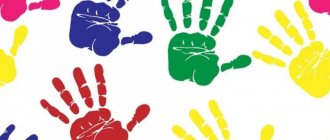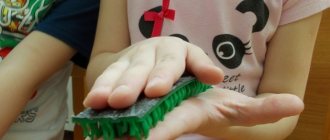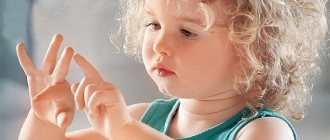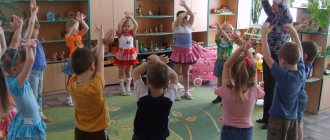Finger gymnastics and its meaning for a child
Research has proven that the development of a child’s speech directly depends on the development of manual motor skills. At a high level, logic, coherent speech, memory and attention are well developed. Moreover, if, upon reaching four years of age, a child cannot bring water to his face in his joined palms, then his manual fine motor skills are lagging behind in development. That’s when parents turn to finger gymnastics for help for their kids.
Finger gymnastics
Methods and goals of finger gymnastics in kindergarten
At the preschool educational institution, classes are conducted on music, physical education, and even walks. The work plan of a general education institution highlights the following goals:
- Development of finger dexterity, imagination and attention.
- Activation of speech centers.
- Creating a positive attitude in the group.
Note! Finger gymnastics in kindergarten is based on the method of influencing the child’s internal organs with the hands.
For example:
- The thumb point is responsible for the functioning of the brain;
- The index finger is responsible for the functioning of the stomach;
- The middle finger controls the integrity of the spine and intestinal tract;
- The liver is associated with the ring finger;
- Heart with little finger.
Additional attraction of the child's attention
Recommendations for conducting finger games with children of any age
You know, I thought that if you work well with children during the preschool period, then although at school the children will completely forget about kindergarten, the acquired knowledge, skills, and habits will remain for life. This is very important for both fellow teachers and every parent to understand.
And finger games are the foundation for your entire future adult life, so find time to play with your son or daughter for 5-10 minutes, and you need to do it like this:
- Before the lesson, be sure to tell your child what you will do, show the movements, let the child try to repeat them without “accompaniment,” then to the accompaniment of poetry or a song. Come up with a code word that you will say every time you have a game planned, children love order in their lives;
- It is clear that always do the exercises together with the baby, while demonstrating real passion, the baby senses falseness;
- Motivate your child to repeat the words of the rhymes after you, gradually the child should be able to independently play the game for you;
- There is no need to change games often; let the children practice 2-3 finger games well before adding a new one or changing the repertoire altogether;
- Always start getting acquainted with finger games with the simplest movements, do not rush, do not criticize or get annoyed if your child cannot immediately master the movement or remember the words. The process should be enjoyable for everyone involved;
- Don’t force him to do the exercises, watch your child’s mood, find a suitable time for this important task when the baby can play with pleasure and exercise his fingers;
- Praise, support, be patient!
I think that's enough information for now. In the end, you have access to thematic literature and videos for teaching simple finger gymnastics movements. My job is to familiarize preschoolers with development methods and motivate adults to work with their children. I hope it works at least sometimes?
Types of exercises for hands and fingers
As a result of playing games for the hands, their muscles are strengthened, the child learns to control the tension and relaxation of the limb. A prerequisite is to show adults the exercise, even if it is familiar to a preschooler.
One such exercise is gates. The palms are directed with the fingers towards each other, placed on the edge. The fingers are tense and straightened. To the command: “The gate is opening,” the palms turn parallel, with the fingers pointing away from you. On the command: “The gate is closing,” the hands return to their original position.
Using the “Let's pet the animal” exercise, you can not only relax your hands, but also bring your child into a dialogue about the pet he has or would like to have - which will also contribute to the development of imagination, thinking and speech. The task itself is simple - first with one hand, then with the second, the child “pets” an imaginary animal.
Important! Conducting finger exercises can begin from infancy - with the mother stroking and massaging the baby’s hands. However, the child will consciously complete tasks no earlier than 4 years old. As a result of this exercise, stiffness in the movements of the fingers and hands will disappear, flexibility and mobility will appear.
Gymnastics for fingers for children. Examples:
- Glasses. The thumbs and index fingers are connected to each other. The resulting “glasses” are brought to the eyes.
- Steamboat. Both palms are placed on the edge and connected, little finger to little finger, forming a ladle. The thumbs are protruded and directed upward.
- Chair and table. Chair - one palm is straightened, and the second is in a fist. The one in the fist is placed at the bottom of the straightened palm, forming a chair. The table is made according to a similar principle, only the straightened palm is placed horizontally on the fist.
Carrying out finger gymnastics in the senior group
We continue to train the fingers of older preschoolers...
At 6-7 years old, children should be able to do a lot, including knowing the names of the days of the week and months. Finger games can also help with this:
I did the laundry on Monday, Paul swept on Tuesday. On Wednesday I baked a loaf of bread, On Thursday I looked for a ball, I washed the saucers on Friday, On Saturday I bought a cake. I invited all my friends to my birthday on Sunday.
This poem contains movements that imitate real actions: washing, cleaning, washing dishes, I think it’s not worth describing in detail.
Since in kindergarten we constantly mix different types of activities to make the learning process more effective, finger games can be combined with creative things. What am I talking about? If you draw funny faces on your fingertips or wear special funny paper caps, the games will be much more fun.
For children in the preparatory group, instead of the usual exercises, you can come up with a whole performance where the action is performed by finger actors. By the way, why not a topic for consultation, a master class for fellow educators or parents of students?
By school, children are already so developed, if we put effort into it, that their brain requires more and more new tasks. So why not teach them the basics of sign language? This is a great workout for your hands, memory and speech. In addition, this can be included in the training program in mixed groups with hearing-impaired and deaf children. The benefit will be mutual!
The simplest gestures indicating different objects and phenomena in sign language are both finger gymnastics and expansion of the boundaries of a child’s consciousness, when from childhood he learns to see people as equals to himself.
Further, shadow theater has proven itself to be an excellent finger game. I remember how, as a child, because we had nothing to do, we would put on a whole show on a white wall with the light of a candle or a kerosene lamp at my grandmother’s: birds were flying, a wolf was running, a bunny... And now, when the lights are suddenly turned off, you can keep your child busy and at the same time develop motor skills.
A special chic is to be able to show figures using both hands! Great training for children, what can I say.
Preparing and conducting finger gymnastics classes at a preschool educational institution
To perform finger and hand gymnastics for children, no special materials are required.
Formation of cultural and hygienic skills in the senior group
Note! The specialist selects exercises based on the age and development level of the group.
Children of the nursery group aged 2-3 years play “animals”, imitating the flapping of the wings of birds or the habits of familiar animals (dog, cat, bear, cockerel, cow). In this case, the teacher first shows the exercises individually, correcting and correcting each one. When this stage is passed, all the studied material is repeated in subgroups.
At the age of 3-4 years, the study of movements that strengthen the hands begins. To do this, tasks are given to depict familiar objects, such as a castle, a hammer, a flower.
4-5 year old children (pupils of the middle group) study both static and dynamic exercises. Gymnastics for fingers in kindergarten is carried out following the example of the teacher, and then the image begins to be modified (the gate opened - the gate closed).
At 5-6 years old (older group), the teacher no longer shows movements, children learn to perceive tasks by ear and reproduce them.
Note! By the sixth year of life, children are happy to organize impromptu “classes” for younger children, based on the exercises they have learned.
By the age of 6-7 years, classes take on the format of an imagination game. Taking an already familiar position, the child must tell the story associated with it, and also modify the position of his hands during his speech. At the age of six, a child, possessing a remarkable imagination, is able not only to retell a story familiar to him, but also to build his own, relying on visual material.
Approximate time plan for finger gymnastics in different age groups
Following the rules of the Federal State Educational Standard, the timing of finger gymnastics in groups of different ages is different. Class time is counted including warm-up and cool-down:
- 5 minutes - for younger preschoolers (2-4 years). In this case: 1 minute for warming up, 2 - for learning a new game, 1 - for repeating the old one, 1 - for massage with special balls.
- 7-9 minutes - for older preschoolers (5-7 years old). In this case: 1 minute for warming up, 1 - for performing static exercises, 2 - for conducting 2 dynamic games, united by a common theme, from 3 to 5 minutes for performing “finger theater”.
Let's start with the smallest fingers...
Experts strongly advise starting finger exercises long before one year.
By about two months, both mother and baby are ready to devote all their time not only to feeding and sleeping, but also to other, no less pleasant and useful activities, for example, massage. Until 5-7 months we limit ourselves to massage. To begin with, we carefully stretch out each finger of the baby, stroking it. Then we make circular movements with each finger. At first we devote a minute to these exercises, then more and more, reaching 3-4 minutes. Balls of different textures are very good, which should be given to the baby so that he squeezes them. From the age of 7 months you can start playing folk games like “ladushki”, “magpie”, “shoemaker”, “horned goat”. The “Hairstyle” exercise is also useful: the baby is in a sitting position, we take his hand and run it over his head from the forehead to the back of the head, as if combing his hair. Then the second handle combs the hair.
Then the baby will be able to brush her own hair. At the same time, don’t forget to say: “Now let’s comb Mashenka, this is the hairstyle” or whatever comes to your mind. We also give the baby a nut and teach him to roll it between his palms - an extremely useful massage for the sensitive points of the palms. At 1 year old, a child can roll a ball or a nut independently, as well as know the movements of simple finger games such as “magpie”.
You can check how developed motor skills are at 1.5 years old: by this age, the baby draws doodles, holds a spoon, a cup, unwraps an object wrapped in a wrapper, assembles a pyramid himself, places 3 cubes on top of each other, can unscrew a screw-on element while playing uses both hands, repeats parents’ actions with objects: presses phone buttons, leafs through a book, grabs a moving object, etc.
At 2 years old we give more complex tasks: we teach how to fasten and unfasten buttons, knit simple knots, pour water from one container to another. You can make a special simulator for the development of motor skills (the video is full on the Internet). We attach all sorts of latches, clasps, laces, and buttons to the board.
At this age, the main movements of finger play are aimed at squeezing the handle into a fist, unclenching, bending and straightening all the fingers together and one by one, and circular movements with the hands.
Finger gymnastics in kindergarten - a card index of games with goals according to the Federal State Educational Standard for the year
| Time spending | Game theme | Target | Junior preschoolers (2-4 years old) | Senior preschoolers (5-7 years old) |
| I period (October, November, December) | Animals, insects and birds | Develop mobility and flexibility of hand joints, enrich passive and active vocabulary |
|
|
| II period (January, February, March) | The coming of winter | Introduce children to the winter holidays, teach how to tense and relax their hands through hand exercises for children |
|
|
| III period (April, May, June) | Family, friendship, clothes | Expanding children's horizons, developing imagination, improving abilities in mathematics and their native language | “Family” - clench your fist tightly and gradually straighten one finger at a time. “Table” - the straightened palm of the second hand is placed horizontally on the clenched fist. “Meeting of friends” - the palms of both hands slowly touch each other. |
|
Work plan for self-education of preschool teacher
In addition to the exercises presented above, the card index can contain tasks on topics of kindergarten, human activity or the objective world around the child.
Important! You can do finger gymnastics at home - on video resources you can see a huge number of examples of performing the exercises. The main thing to remember is that each game should be accompanied by a thematic fairy tale or a short poem. In addition to the exercises presented above, the card index may contain assignments on topics in kindergarten, human activity, or the objective world around the child.
Subgroup lesson
The role of finger games in the development of a child’s speech
Kalimanova Lina Stanislavovna Pashina Tatyana Vladimirovna Reznikova Anna Vladimirovna teachers MBDOU d/s No. 6g. Belgorod
The material was sent for publication in the All-Russian printed collection of practice-oriented materials “Preschool and primary education - modern methods and technologies of teaching and upbringing” - OCTOBER 2022.
THE ROLE OF FINGER PLAYS IN THE DEVELOPMENT OF A CHILD’S SPEECH
The formation of a child’s oral speech begins when the movements of the fingers reach sufficient accuracy. When a child makes rhythmic movements with his fingers, the coordinated activity of the frontal (motor speech zone) and temporal (sensory zone) parts of the brain sharply increases, that is, speech areas are formed under the influence of impulses coming from the fingers. To determine the level of speech development of children in the first years of life, the following method has been developed: the child is asked to show one finger, two fingers, three. Children who succeed in isolated finger movements are speaking children... Until the finger movements become free, the development of speech and, consequently, thinking cannot be achieved.
Advertising message
This is also important for timely speech development, especially in cases where this development is impaired. In addition, it has been proven that both the child’s thought and eye move at the same speed as the hand. This means that systematic exercises to train finger movements are a powerful means of increasing brain performance. The level of speech development in children is always directly dependent on the degree of development of fine movements of the fingers. Imperfect fine motor coordination of the hands and fingers makes it difficult to master writing and a number of other educational and work skills. Psychologists say that finger exercises develop a child’s mental activity, memory and attention.
In order to learn to think and speak, you need to be able to see, listen and hear, that is, process and comprehend information received from the world around you. The baby must be given plenty of time to feel, touch, knock, smell, look, and taste. When the baby has accumulated rich impressions and, accordingly, his own vocabulary, then the long-awaited moment will come - the child will “suddenly” speak on his own. From this happy day, speech will become a full-fledged means of communication for him.
Speech is improved under the influence of kinetic impulses from the hands, or more precisely, from the fingers. Typically, a child who has a high level of development of fine motor skills is able to reason logically, his memory, attention, and coherent speech are sufficiently developed.
For the formation of a comprehensively developed personality, the importance of finger games is very great. Therefore, finger games should be used in various types of children’s activities as often as possible, but not for long. By doing this, we contribute to the activation of thought processes, the development of speech and imagination of children. It was also noted that the better developed a child’s hands are and the more actively his fingers work, the faster he begins to speak and easily copes with the pronunciation of complex sounds. The logical conclusion suggests itself that finger games are simply irreplaceable for speech development. And there is an explanation for this - the formation of the cerebral cortex depends on the development of our limbs, namely the hands and fingers. And as soon as the baby’s hand acquires flexibility and plasticity, he begins to speak verbally.
The question “what are finger games for” can be easily answered by any specialist. These simple finger exercises will help synchronize the work of the left and right hemispheres, creating a kind of bridge between them. The left hemisphere is responsible for verbal speech during the game, and the right hemisphere is responsible for the development of fantasy and imagination. And if the connection between them is strong, then nerve impulses pass more often and faster, activating the child’s thinking and attention.
Finger games for kids are not know-how. Their existence was known in ancient times among different peoples. In China, for example, exercises with balls are very popular, rolling which helps improve memory, strengthen the cardiovascular system and improve the functioning of the digestive tract. They relieve stress, develop dexterity and hand strength. In Japan, walnuts were used instead of balls, and in Russia, children were taught such famous games as “Horned Goat”, “Magpie-Crow” and “Ladushki”. And today the importance of finger games is so great that they have been adopted by specialists.
For the speech and intellectual development of preschool children, we also use finger games as in the classroom. So it is in free activity. In the role-playing games “Let's cook porridge”, sorting beans or “Collect scattered beads”, various games with building materials, with laces and various types of mosaics and others.
Finger games without objects with speech accompaniment.
Finger games are the staging of any rhymed stories or fairy tales using the fingers; they are a very important part of the work on developing fine motor skills. These games are very emotional and exciting. They promote the development of speech and creative activity. “Finger games” seem to reflect the reality of the surrounding world - objects, animals, people, their activities, natural phenomena. During these games, children, repeating the movements of adults, activate hand motor skills. Thus, we develop dexterity, the ability to control our movements, and concentrate attention on one type of activity.
1.
The cunning eccentric hedgehog sewed a prickly jacket. A hundred needles on the chest, A hundred needles behind. The hedgehog walks on the grass, pokes pins into pears, plums, and any fruit that he finds under the tree. And with a gift to the rich he returns to the guys
2.
There is a Christmas tree in the forest, There is grass under the Christmas tree. There are flowers on the grass, There is a path on the grass, Katenka is walking along the path.
Relaxation of fingers and hands
The child reproduces actions with some real object. “Painting the fence” movement of the hand up and down, left and right.
- “Let's pet the kitten” smooth stroking movements are performed first with one hand, then with the other.
- “The chicken is drinking water”: the elbows rest on the table, the fingers are folded in the shape of a cranberry, the arms are rhythmically tilted forward.
- “Musicians”, with hand movements, the child copies playing various musical instruments.
Nursery rhymes for finger massage
It is advisable to finish finger gymnastics with these nursery rhymes - exercises, since they contain elements of massage. The texts are accompanied by stroking, rubbing, bending and straightening the fingers. In these poems you can bend your fingers, starting with the thumb, then with the little finger, then on the right, then on the left hand.
"Once upon a time there lived mice"
One two three four! The mice lived in an apartment; They drank tea, broke cups, paid three pieces of money! We hold our palm open and move our finger along it.
"Fingering"
The white kitten has soft paws. But on each paw there are claws - scratches! Then alternately with a soft brush, then with a hard brush.
Self-massage of hands and fingers
- Pressing tightly squeezed four fingers of one hand on the base of the thumb, the middle of the palm, the base of the fingers of the other hand.
- Rubbing your palms with a hexagonal pencil with a gradual increase in effort.
- Rubbing your palms with up and down movements.
- Rubbing the lateral surfaces of clasped fingers.
- Kneading, then rubbing each finger lengthwise, then crosswise.
- Place the walnut between your palms and make circular movements, gradually increasing the pressure and pace. You can do the exercise with two walnuts, rolling one over the other, with one hand, then with the other.
- Kneading the right hand with the fingers of the left and vice versa, then rubbing alternately.
We use characters and images of finger games: a spider and a butterfly, a goat and a bunny, a tree and a bird, sun and rain, children like it, and children are happy to repeat the texts and movements of adults. Some finger games prepare the baby for counting, while in others the child must act using both hands, which helps to better understand the concepts of above and below, above and below, right and left.
Having chosen two or three exercises, we gradually replace them with new ones. We keep the games we like most in our repertoire and return to them at the request of the kids.
Finger games give adults the opportunity to play with children, delight them and, at the same time, develop speech and fine motor skills. Thanks to such games, the child receives a variety of sensory impressions, he develops attentiveness and the ability to concentrate. Such games form good relationships between adults and children.
What happens when a child does finger gymnastics?
- Performing exercises and rhythmic movements with the fingers inductively leads to excitation in the speech centers of the brain and a sharp increase in the coordinated activity of speech zones, which ultimately stimulates the development of speech.
- Finger games create a favorable emotional background, develop the ability to imitate an adult, teach them to listen attentively and understand the meaning of speech, and increase the child’s speech activity.
- Children learn to concentrate their attention and distribute it correctly.
- If a child performs exercises, accompanying them with short poetic lines, that is, speech will become clearer, rhythmic, bright, and control over the movements performed will increase.
- Children's memory develops as they learn to remember certain hand positions and sequences of movements.
- As a result of finger exercises, the hands and fingers will gain strength, good mobility and flexibility, and this will make it easier to master writing skills in the future.
Literature:
- “Entertaining games and exercises with finger alphabet” E.N. Ryzhankova, Moscow, Sfera, 2010.
- “Mind at your fingertips” O.A. Novikovskaya, AST, Sova, 2008.
- “Issues of studying children's speech” A.N. Gvozdev, Childhood - press, 2007.
- “Finger gymnastics for the development of speech in preschoolers” A manual for parents and teachers. L.P. Savina, Moscow, AST, 1999.
- “Finger games” by E. Zheleznova, Bryansk, 2015.
- “The role of speech in the development of children’s perception” A.A. Lyublinskaya, Psychology of the preschool child: a reader. – Moscow, 2000.
You can see the table of authors and learn more about the collections HERE
Analysis and diagnosis of finger gymnastics in preschool educational institutions
Diagnostics of the exercises carried out consists of 3 stages:
- The level of development of children's skills in September is recorded;
- Interim results are measured in the middle of the year (January - February);
- The results of the effectiveness of finger gymnastics are summed up at the end of the year (June).
Note! Carrying out finger gymnastics allows you to evaluate and correct the coordination of movements and the development of fine motor skills in a playful way for both younger and preschool children.







